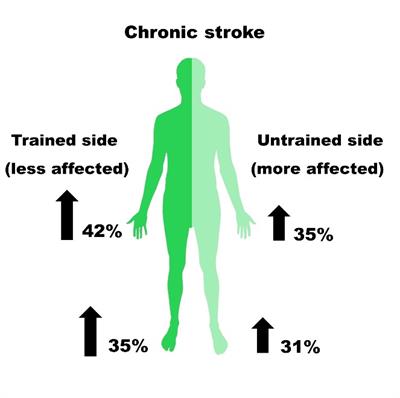Diba Mani, Ph.D. |
Oct.
17, 2019
Neurotraumatic injury such as stroke is not typically symmetrical. So, it is no surprise that such damage results in a more affected side, which results in more dramatic muscle weakness and spasticity. However, evidence suggests that some human movements have conserved neural linkages even post-stroke. Thus, training the more affected side made indeed enable the re-strengthening of muscles and neural pathways. So, what kind of training can rehabilitation specialists consider prescribing to their patients?
 Cycling is one suggestion. Measures of mobility were improved following arm or arm-leg cycling. What about strength training? In the October 2019 issue of Exercise and Sport Sciences Reviews, researchers Yao Sun and E. Paul Zehr suggest that strength training can have significant impacts on neuroplasticity, even with just unilateral training. Significant strength gains have been revealed by cross-education in both the lower extremity and upper. The positive impact of cross-education in those who have experienced stroke compared with those who are neurologically intact is nearly astoundingly greater for all limbs, trained and untrained sides.
Cycling is one suggestion. Measures of mobility were improved following arm or arm-leg cycling. What about strength training? In the October 2019 issue of Exercise and Sport Sciences Reviews, researchers Yao Sun and E. Paul Zehr suggest that strength training can have significant impacts on neuroplasticity, even with just unilateral training. Significant strength gains have been revealed by cross-education in both the lower extremity and upper. The positive impact of cross-education in those who have experienced stroke compared with those who are neurologically intact is nearly astoundingly greater for all limbs, trained and untrained sides.
But wait! The cross-education doesn’t stop at bodily hemispheres of left and right! Zehr showed that the upper and lower limbs share neural control elements during locomotion (i.e., walking, cycling). Other rhythmic movement training regiments can, therefore, facilitate walking. Zehr and Sun expands on this marvelous aspect of neuroplasticity in their recently published paper in Exercise and Sport Science Reviews. The capability of transferring improvements to movements and limbs not directly trained, as shown by Klarner et al. in a 6-week moderate arm and leg cycling training in patients with chronic stroke, advocates the hypothesis that rhythmic movements are regulated by the same basic neural networks.
Similar to our four-legged animal friends, where an injury to one limb does not prevent locomotion, injuries to one leg of the bipedal human can have symptoms ameliorated, likely by similar neural control mechanisms. Human interlimb modulation is present between legs and the upper and lower limbs, as revealed by changes in H-reflex amplitude in ipsilateral and contralateral sides of the body, even outside of locomotion.
Certainly, Zehr and Sun make a solid argument for the superior capabilities of our plastic nervous system, especially following stroke. Engaging multiple limbs in training programs can have an impactful influence on regaining strength after stroke.
How can you help your students better grasp the concepts of how activating interlimb neural networks can amplify strength gain and neural plasticity? Check out the online-only Journal Club questions written by the authors to help students think critically about the topic. It includes questions such as:
Compared to training the more affected limb directly, what are the benefits of training the less affected limb after stroke?
Diba Mani, Ph.D., is a lecturer in the Department of Applied Physiology & Kinesiology at the University of Florida. She serves as the Digital Editor for Exercise and Sport Sciences Reviews. She earned her degrees under the mentorship of Dr. Roger Enoka in the Neurophysiology of Movement Laboratory at the University of Colorado. Her doctoral dissertation focused on evaluating the effects of electrical nerve stimulation on motor unit discharge properties and mobility in young and older adults. Dr. Mani most enjoys the human component of any work she is engaging in, be it research in the field of geriatrics or teaching college students in the classroom. Dr. Mani is a nationally certified judo referee and coach and also a regular vinyasa yoga practitioner. She is passionate about diversity and cultural promotion through involvement in groups such as Iranian American Academics & Professionals and the Persian Students Organization.